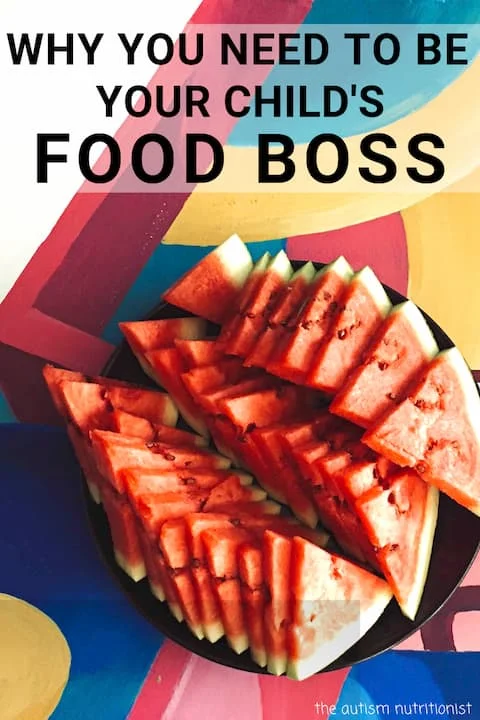
Lisa, a mom I’m working with in my Autism Nutrition Program, warned me when we started working together that her son, Eli, dictates what he eats for meals and snacks.
I’ve actually seen him in action. When it’s time for a meal, Eli makes his request and stubbornly sticks to it, refusing any additions or modifications. If he doesn’t get help making what he wants, he actually goes into the kitchen to get it himself, going as far to climb on the counters to get his meal.
In our first session together, Lisa was really excited about bringing more routine into her meals and creating a mealtime schedule. She thought Eli would actually really like that. She worried, though, that he wouldn’t do well with not getting what he wanted, having new foods on his plate, and eating the family meal. Lisa knew that it wasn’t great that she let Eli decide what he was eating all of the time, but she didn’t know what else to do. He is hungry all of the time. He’s so picky (his diet has less than 10 foods) and she just wants him to stay on his growth curve (plus, dealing with his meltdowns was exasperating).
I completely understand that. And I’m sure you do, too. But the thing is, when your child creates the menu, he ends up eating what he likes – in Eli’s case, oatmeal and pop tarts – all day long and never has the opportunity to expand his diet and learn to eat new, healthier foods.
When that happens, it doesn’t help your child learn to eat new foods and get healthier and it doesn’t get you closer to your goal of expanding and improving your child’s diet. ⠀⠀
I love including kids in food decisions, but it is the caregiver’s role to provide foods that help kids thrive, not the kids’.
Autism Picky Eating and the Division of Responsibility
So what do you do when your child is used to picking meals? How do you adjust the division of responsibility so you are in charge of choosing the foods that are served and when? (If you’re not familiar, the Division of Responsibility, created by a dietitian named Ellyn Satter, says that parents are in charge of the what, when, and where of feeding, while kids decide if they eat and how much).
Remember that as the parent, it is your role to provide for your child. That means setting and sticking to mealtimes and creating the menu. You can still offer food choices to your picky eater on the spectrum. Including your child in food decisions and even food prep can increase his motivation to eat. Beyond that, it increases a child’s exposure to new foods, which makes them feel more familiar, and also makes your child feed involved. Involvement is key for a child who is used to making all of the food decisions.
Picky Eating and Autism: Giving Your Child Freedom to Choose
Ideally you are making the big decisions about meals and you are including your child in easy decisions that still maintain the structure of what you want to serve.
Do this by offering simple choices:
-
“Would you prefer a granola bar or trail mix for snack?”
-
“Should I prepare berries or apples slices?”
-
“How would you like the chicken prepared for tomorrow night, breaded or grilled, in strips or patties?”
When you’re giving choices, be sure that each option is similar. I don’t recommend offering open-ended choices (“What do you want for breakfast?”) or offering drastically different food options (“Should we have broccoli or cookies with lunch?”).
Expanding the Autism Diet: One Daily Meal is Theirs
You can also designate one meal a day when your child in charge. I like snack. For that meal, your child can pick the menu. I would still include some limits by creating a list of acceptable choices that you share either verbally or visually (because maybe ice cream every day of the week shouldn’t be an option). Make the list large enough and be sure it includes some foods you know your child will be happy picking, even if they’re not at the top of your list.
The Autism Meal Plan: Include One New Food
When your child is selecting the menu, still provide a small serving of a new food alongside what he picks. It’s okay if he doesn’t eat it or opts to move it away from his seat. Offering the new food will help him get used to this new meal structure and will still increase his food exposure.
The most important thing is to find a way to give your child the control he wants while still offering new foods at meals and snacks.
Recap
It is your role as a parent to decide what foods you serve your child and when. Some kids, especially picky eaters, are used to picking their own meals and creating their own eating schedules. This won’t help them expand their diets. Offering your child simple choices will make him feel involved while still putting you in charge.
Homework
Evaluate how meals happen in your house. Can you start using any of the suggestions in this article to make some changes?
And! Personalized Support
If you want an individualized approach to help your child try new foods without a meltdown, consider my autism nutrition coaching program. You can sign up for a free coaching call HERE.



0 Comments